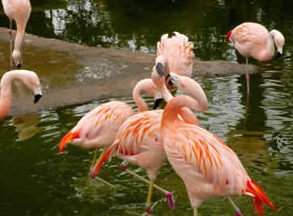Flamingos in captivity require a special diet to ensure they preserve their striking colors. Zoos like the San Diego Zoo and Animal Park use special flamingo pellets enriched with pigment. Captive flamingos also require water so that they can eat by pumping water through their bills, as they do in the wild.

Flamingos at San Francisco Zoo. In the wild, flamingos eat algae, crustaceans, brine shrimp, diatoms, and aquatic plants. At the zoo, a special “flamingo fare” is served. To preserve their rosy color at the zoo, flamingos are fed a commercially prepared diet high in carotenoids. Initially, zoos fed carrots, red peppers, and dried shrimp to flamingos, but it was found that if synthetic canthaxanthin was added to their feed, nesting and breeding were more successful.
What do zoo flamingos and farmed salmon have in common?
Both salmon farmers and zookeepers rely on doses of a carotenoid, such as canthaxanthin or a similar pigment, to keep fish and flamingos colorful. In both cases, this pigment is responsible for mimicking the color found naturally in wild species. In zoos, flamingos need a diet rich in carotenoids to maintain their distinctive plumage. Carotenoids also occur in mollusks and crustaceans, so flamingos may be fed shrimp and clams. Spoonbills and pink ibis also rely on ingested carotenoids for their coloring.


